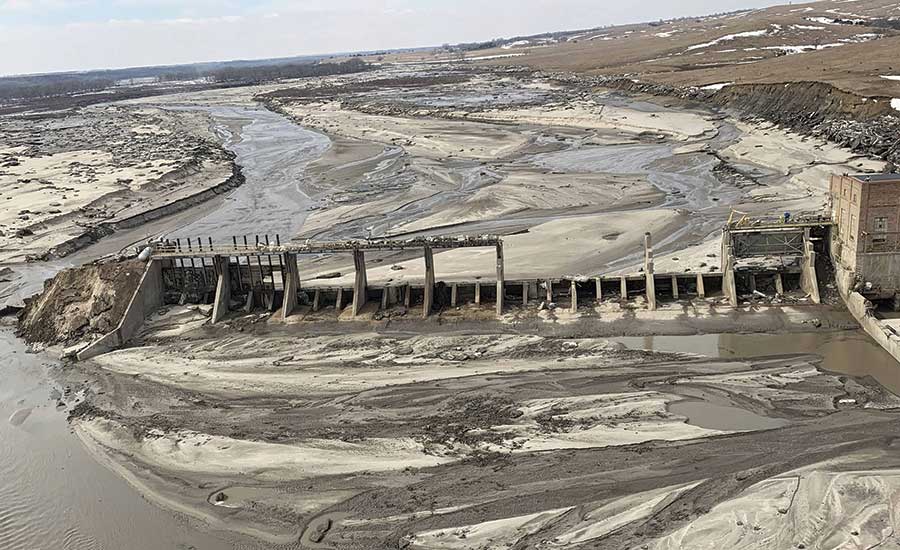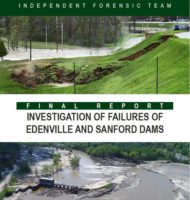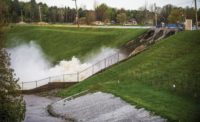When the Platte and Missouri river systems could not drain the rain and ice from the "bomb cyclone" weather event in northeast Nebraska in March 2019, the Spencer Dam on the Niobrara River was swept away and a resident that lived just below it, 71-year-old Kenny Angel, was killed in the ensuing flood.
A new report on the failure by the Association of State Dam Safety Officials says dam owners and state authorities must do a better job of preparing for such ice runs on rivers in northern climates, while also finding that authorities need to collect and provide more information about the history of dams such as Spencer. The report says ice chunks, some weighing tons, clogged the gates, caused overtopping of its earthen berm and, eventually, overwhelming what remained of the run of river dam.
"A major rainstorm occurred on March 13th, 2019 causing the melting of snow on the ground," says Mark Baker, principal at Dam Crest Consulting and the ASDSO investigation panel's leader. "The ground was frozen and runoff quickly swelled the Niobrara River. Ice in the river floated to the surface in large blocks, and they were carried downstream by the flood. These thousands of blocks were the size of large pickup trucks, and weighed between two and 20 tons. As obstructions in the river occurred, these ice blocks or ice rubble as we call them in the report, piled up forming ice jams, which backed up flood water."
The Stuart-Naper Bridge, about 25 miles upstream from Spencer Dam, was destroyed by the ice and water flow, then the ice run damaged the Nebraska Highway 11 bridge 12 miles upstream, according to the report. The report lays out the most likely scenario based on the facts the team gathered, but no one is sure of exactly how and when the dam failed or when Angel, whose house was near a campground he managed just downstream from the dam, was swept away.
Based on the information, the team says at about 4:30 a.m. on March 14, the ice run and flood entered the reservoir above the Spencer Dam. The ice rubble clogged the spillway gates, and water rose behind the dam. Ice was pushed up onto and over the crest of the dam's earthen embankment. The downstream slope eroded, and at about 5:15 a.m. two breaches formed in the dyke, and the flood and ice run continued downstream.
While ASDSO maintains a database of more than 380 dam failures, Spencer Dam's history was largely absent from available data since its construction was completed in 1927. ASDSO's research discovered that the dam suffered a failure due to ice in 1935, again in 1960 and the dam's gates and powerhouse were again damaged by ice in 1966. Nebraska has close to 3,000 dams in its inventory and information beyond state inspection results is largely unknown.
"State dam safety programs need to be vigilant for signs of excessive workload. State governments need to adequately fund and support their state dam safety programs," Baker said.
Nebraska's Dam Safety Program and the Spencer Dam owner, the Nebraska Public Power District, both agreed to the investigation by ASDSO shortly after the Spencer Dam's failure. Neither the state nor the dam owner had any input into the selection of the panel members even though the investigation was funded jointly by NPPD and ASDSO. The investigation found that the dam was well-maintained by NPPD, despite being in the process of being sold to the Nebraska Parks and Game Commission at the time of its failure. The transaction was never completed.
"We found it was well maintained, but the missing piece of the puzzle that contributed to the failure was that the maintenance was being done for typical dam activities like controlling seepage, and taking care of plants that grow on the dam, bushes and trees," Baker said. "But no one was asking the question, 'well, what about ice runs? How is does the dam perform in the spring when the ice comes down the river?'"
The U.S. Army Corps of Engineers has created an ice manual and updates it annually, Baker said, but there isn't a lot of other guidance on how to design or modify dams to pass ice runs. Baker also noted that modifications made to the Spencer Dam in the '40s made the dam's spillway gates more narrow and exacerbated the threat of ice runs rather than mitigating it.
The report also noted that NPPD personnel at the dam knocked on Angel's door and advised him to flee hours before the failure. The last two remaining NPPD employees only fled themselves when water was observed in the powerhouse hours before the dam collapsed. The report said NPPD had no communication plan for such an event and didn't have Angel's phone number, necessitating the late-night visit.
"That's what's identified in our report as a need [to better prepare it for ice runs]. To modify the Spencer Dam, they would have had to incur the cost, at great cost, of putting a very long, ungated structure or a spillway made of very substantial concrete that could take a massive ice run like this... This was a tragedy that this dam failed, and someone lost their life, and we want to make sure it doesn't happen again."
The full report is available to the public. In addition to Baker, whose expertise is in dam safety programs and human factors, the panel consisted of Rob Ettema, a professional engineering professor at Colorado State University with expertise in ice; Martin Teal, vice president of WEST Consultants with expertise in flood hydraulics and hydrology; and John Trojanowski, president of Trojanowski Dam Engineering who brought expertise in hydraulic structures to the panel.






Post a comment to this article
Report Abusive Comment